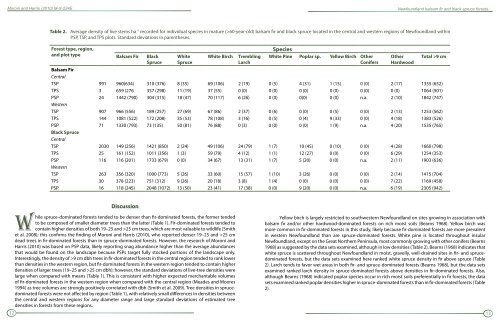Newfoundland balsam fir and black spruce forests described by the ...
Newfoundland balsam fir and black spruce forests described by the ...
Newfoundland balsam fir and black spruce forests described by the ...
Create successful ePaper yourself
Turn your PDF publications into a flip-book with our unique Google optimized e-Paper software.
Moroni <strong>and</strong> Harris (2010) M-X-224E <strong>Newfoundl<strong>and</strong></strong> <strong>balsam</strong> <strong>fir</strong> <strong>and</strong> <strong>black</strong> <strong>spruce</strong> <strong>forests</strong>....<br />
12<br />
Table 2. Average density of live stems ha -1 recorded for individual species in mature (>60-year-old) <strong>balsam</strong> <strong>fir</strong> <strong>and</strong> <strong>black</strong> <strong>spruce</strong> located in <strong>the</strong> central <strong>and</strong> western regions of <strong>Newfoundl<strong>and</strong></strong> within<br />
PSP, TSP, <strong>and</strong> TPS plots. St<strong>and</strong>ard deviations in paren<strong>the</strong>ses.<br />
Forest type, region,<br />
<strong>and</strong> plot type<br />
Balsam Fir Black<br />
Spruce<br />
Discussion<br />
White<br />
Spruce<br />
White Birch Trembling<br />
Larch<br />
While <strong>spruce</strong>-dominated <strong>forests</strong> tended to be denser than <strong>fir</strong>-dominated <strong>forests</strong>, <strong>the</strong> former tended<br />
to be composed of smaller diameter trees than <strong>the</strong> latter (Table 1). Fir-dominated <strong>forests</strong> tended to<br />
contain higher densities of both 19–25 <strong>and</strong> >25 cm trees, which are most valuable to wildlife (Smith<br />
et al. 2008); this con<strong>fir</strong>ms <strong>the</strong> finding of Moroni <strong>and</strong> Harris (2010), who reported denser 19–25 <strong>and</strong> >25 cm<br />
dead trees in <strong>fir</strong>-dominated <strong>forests</strong> than in <strong>spruce</strong>-dominated <strong>forests</strong>. However, <strong>the</strong> research of Moroni <strong>and</strong><br />
Harris (2010) was based on PSP data, likely reporting snag abundance higher than <strong>the</strong> average abundances<br />
that would be found on <strong>the</strong> l<strong>and</strong>scape because PSPs target fully stocked portions of <strong>the</strong> l<strong>and</strong>scape only.<br />
Interestingly, <strong>the</strong> density of >9 cm dbh trees in <strong>fir</strong>-dominated <strong>forests</strong> in <strong>the</strong> central region tended to rank lower<br />
than densities in <strong>the</strong> western region, but <strong>fir</strong>-dominated <strong>forests</strong> in <strong>the</strong> western region tended to contain higher<br />
densities of larger trees (19–25 <strong>and</strong> >25 cm dbh); however, <strong>the</strong> st<strong>and</strong>ard deviations of live-tree densities were<br />
large when compared with means (Table 1). This is consistent with higher expected merchantable volumes<br />
of <strong>fir</strong>-dominated <strong>forests</strong> in <strong>the</strong> western region when compared with <strong>the</strong> central region (Meades <strong>and</strong> Moores<br />
1994) as tree volumes are strongly positively correlated with dbh (Smith et al. 2009). Tree densities in <strong>spruce</strong>dominated<br />
<strong>forests</strong> were not affected <strong>by</strong> region (Table 1), with relatively small differences in densities between<br />
<strong>the</strong> central <strong>and</strong> western regions for any diameter range <strong>and</strong> large st<strong>and</strong>ard deviations of estimated tree<br />
densities in <strong>forests</strong> from <strong>the</strong>se regions.<br />
Species<br />
White Pine Poplar sp. Yellow Birch O<strong>the</strong>r<br />
Conifers<br />
O<strong>the</strong>r<br />
Hardwood<br />
Total >9 cm<br />
Balsam Fir<br />
Central<br />
TSP 991 960(634) 310 (376) 8 (35) 69 (106) 2 (19) 0 (5) 4 (31) 1 (15) 0 (0) 2 (17) 1355 (652)<br />
TPS 3 659 (276 357 (298) 11 (19) 37 (55) 0 (0) 0 (0) 0 (0) 0 (0) 0 (0) 0 (0) 1064 (501)<br />
PSP 24 1442 (790) 304 (315) 18 (47) 70 (117) 6 (26) 0 (0) 0(0) 0 (0) n.a. 2 (10) 1842 (747)<br />
Western<br />
TSP 907 966 (556) 189 (257) 27 (69) 67 (86) 2 (37) 0 (6) 0 (0) 0 (5) 0 (0) 2 (13) 1253 (562)<br />
TPS 144 1081 (522) 172 (208) 35 (53) 78 (108) 3 (16) 0 (5) 0 (4) 9 (33) 0 (0) 4 (18) 1383 (526)<br />
PSP 71 1330 (793) 73 (135) 50 (81) 76 (88) 0 (3) 0 (0) 0 (0) 1 (9) n.a. 4 (20) 1535 (765)<br />
Black Spruce<br />
Central<br />
TSP 2030 149 (256) 1421 (850) 2 (24) 49 (106) 24 (79) 1 (7) 10 (45) 0 (10) 0 (0) 4 (28) 1660 (798)<br />
TPS 25 161 (152) 1011 (356) 1 (3) 59 (79) 4 (12) 1 (1) 12 (27) 0 (0) 0 (0) 6 (29) 1254 (353)<br />
PSP 116 116 (201) 1733 (679) 0 (0) 34 (67) 13 (31) 1 (7) 5 (20) 0 (0) n.a. 2 (11) 1903 (636)<br />
Western<br />
TSP 263 356 (320) 1000 (773) 5 (26) 33 (60) 15 (57) 1 (10) 3 (26) 0 (0) 0 (0) 2 (14) 1415 (704)<br />
TPS 30 378 (223) 751 (312) 9 (26) 20 (18) 3 (8) 1 (4) 0 (0) 0 (0) 0 (0) 7 (22) 1169 (458)<br />
PSP 16 118 (245) 2048 (1072) 13 (50) 23 (41) 17 (38) 0 (0) 9 (20) 0 (0) n.a. 6 (19) 2305 (942)<br />
Yellow birch is largely restricted to southwestern <strong>Newfoundl<strong>and</strong></strong> on sites growing in association with<br />
<strong>balsam</strong> <strong>fir</strong> <strong>and</strong>/or o<strong>the</strong>r hardwood-dominated <strong>forests</strong> on rich moist soils (Bearns 1968). Yellow birch was<br />
more common in <strong>fir</strong>-dominated <strong>forests</strong> in this study, likely because <strong>fir</strong>-dominated <strong>forests</strong> are more prevalent<br />
in western <strong>Newfoundl<strong>and</strong></strong> than are <strong>spruce</strong>-dominated <strong>forests</strong>. White pine is located throughout insular<br />
<strong>Newfoundl<strong>and</strong></strong>, except on <strong>the</strong> Great Nor<strong>the</strong>rn Peninsula, most commonly growing with o<strong>the</strong>r conifers (Bearns<br />
1968) as suggested <strong>by</strong> <strong>the</strong> data sets examined, although in low densities (Table 2). Bearns (1968) indicates that<br />
white <strong>spruce</strong> is scattered throughout <strong>Newfoundl<strong>and</strong></strong> in moist, gravelly, well-drained sites in <strong>fir</strong>- <strong>and</strong> <strong>spruce</strong>dominated<br />
<strong>forests</strong>, but <strong>the</strong> data sets examined here ranked white <strong>spruce</strong> density in <strong>fir</strong> above <strong>spruce</strong> (Table<br />
2). Larch tends to favor wet areas in both <strong>fir</strong>- <strong>and</strong> <strong>spruce</strong>-dominated <strong>forests</strong> (Bearns 1968), but <strong>the</strong> data sets<br />
examined ranked larch density in <strong>spruce</strong>-dominated <strong>forests</strong> above densities in <strong>fir</strong>-dominated <strong>forests</strong>. Also,<br />
although Bearns (1968) indicated poplar species occur in rich moist soils preferentially in <strong>fir</strong> <strong>forests</strong>, <strong>the</strong> data<br />
sets examined ranked poplar densities higher in <strong>spruce</strong>-dominated <strong>forests</strong> than in <strong>fir</strong>-dominated <strong>forests</strong> (Table<br />
2).<br />
13

















